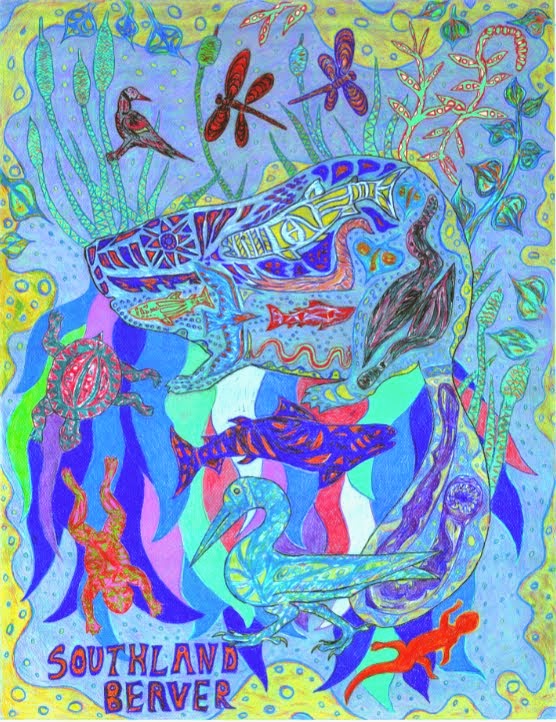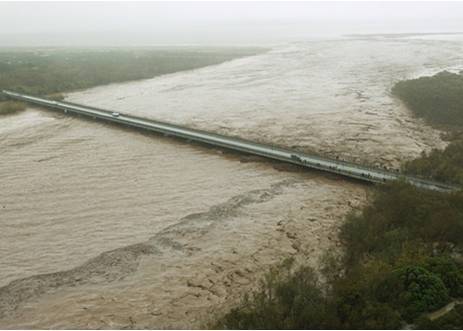Among the river systems of southern California it is the Santa Clara River that offers perhaps the most promising hope for restorations. Unlike the Santa Ynez river it is not dammed. Unlike the Los Angeles, San Gabriel, and Santa Ana rivers it is not channelized. As the largest river system in southern California that is not dammed and not channelized the Santa Clara has garnered much attention from groups such as the Nature Conservancy who are working to protect large chunks of this watershed. Many unique and imperiled species utilize the Santa Clara River as habitat. Riparian species of concern include western pond turtle, unarmored three spine stickleback, tidewater goby, southern steelhead, pacific lamprey, Santa Ana sucker, arroyo toad, southwestern willow flycatcher, least bell's vireo, western yellow-billed cuckoo, and red-legged frogs- among others. Additionally the Santa Clara River maintains connectivity with many of its tributaries the larger including Sespe Creek, Santa Paula Creek, Piru Creek, and Castaic Creek. Several of these creeks, most notably the Sespe, are undammed and offer miles of prime steelhead habitat and produce ocean bound smolts annually. Regular readers should recognize Sespe Creek as the source creek from which a beaver specimen was captured in 1906 by Dr. John Hornung and was a foundational piece in the recently published paper by Lanman et al proving the historical presence of beaver in coastal southern Californian streams. But more on the prospects of beaver reintroduction into this watershed later.
Despite the rosy picture I paint the Santa Clara has some definite issues. Chief among these are invasive plants and animals (especially the giant reed Arundo donax), agricultural and urban runoff, groundwater pumping, agricultural diversions, and last, but not least, the Vern-Freeman diversion installed in 1991. For a brief history of the dam check this out. This diversion was built to direct flows from the river to recharge the Oxnard aquifer and protect against salt-water intrusion. The Oxnard plain is an agricultural hub. Chances are if you eat a lot of strawberries you have probably ate an Oxnard strawberry, which was watered by water provided by the Vern-Freeman diversion, which was water taken from the Santa Clara River. While at first the diversion was hailed as a major success - increased reliance on high water crops, miscalculations on the amount of water that can be withdrawn, the recognition of southern steelhead as federally endangered species in 1997, and several drought episodes including the current one - have all compiled to put the diversion and the agency that runs it, United Water, through some very pressing times. United Water has went through and is currently engaged with several lawsuits ranging from municipality water rates to securing better flows and passage for fish movement.
It is in this context that southland beaver was permitted to view and be granted access to the diversion by the senior fisheries biologist employed at United Water's Vern-Freeman diversion dam, Steve Howard. For reference sake the diversion is located about 1/2 between Santa Paula and the ocean on the map above.
Senior Fisheries Biologist Steve Howard explains Vern-Freeman Diversion Santa Clara River
Now, here I want to thank Steve again for spending two hours of his time taking me around and answering all of my questions. I was pleased to find out he is a true fish guy and this was good news because I had long held negative connotations for United Water with regards to their fish work. But Steve seems like the right guy for the job and as we talked I could see he really was making some strident efforts for steelhead and lamprey (don't forget the lamprey!!) in this river. I learned that because of downstream down cutting of the river due to quarry work, the diversion was actually offering some benefit by preventing the down cutting to continue upstream.
So what kind of fish passage does the Vern-Freeman have? Well watch the video below as Steve explains the Denil fish way they use, why it is not the best system for the river, and how they are going to improve it. World exclusive on southland beaver!!
Denil Fishway on Vern-Freeman and New Passageway Coming!!
Did you catch all that? The problem with this particular fish passageway on this particular river is that when the Santa Clara rages, it really rages. Steve told me he has seen the river in such flow that as it crossed the diversion wall, it scarcely dropped in height at all. Now for a steelhead trying to find its way upstream in such a torrent, in flows that come and go quickly, it may miss it's opportunity to pass by keying in on the area of highest flows (the diversion wall itself) and missing the passageway. Let us look a bit at the Denial fish passageway.
Denil Fish Passageway
Now if a steelhead makes it up through the ladder, how would Steve know that it made it through? Well it turns out that the steelhead on this particular passageway are some of the most highly scrutinized fish in the world. Steelhead have to pass through a point where they are on motion detection camera from two angles as well as infrared detection. Pretty sweet...
So despite all the difficulties with steelhead on this river going through this particular diversion- have any made it through? Turns out yes, in 2012 two mature ocean-grown steelhead made it back up and through the diversion. Steve has the video to prove it which I will show below.
Well need less to say Steve said he was jumping through the roof when those two steelies made it through in 2012.
Some may wonder- why are all these resources and water being given to a fish?
Now for me southern steelhead are some of the coolest fish around. I mean big fish like those two make it up through largely intermittent to totally dry rivers during brief high flow events in a mad dash to their spawning grounds in perennial, spring and snowmelt fed streams. For any readers here from more wetter parts of the world the picture below shows how much of the lower Santa Clara looks the vast majority of the year, if not a sandy wash.
Until it looks like this:
And even with all the crap we throw at them they still make a go at it. People can learn a lot from this fish in my estimation. That fish to me is very inspiring, more so than most humans at least.
More to come including how channel maintenance is achieved, fish traps, settling ponds, percolation, bird life at the diversion, problems with badgers and I ask the question:
Is the Vern-Freeman diversion doing what beaver would do naturally? (and for free)
Support me on Patreon.
Like antediluvian salad on facebook.
Watch me on Deviantart @NashD1.Subscribe to my youtube channel Duane Nash.
My other blog antediluviansalad.blogspot





No comments:
Post a Comment